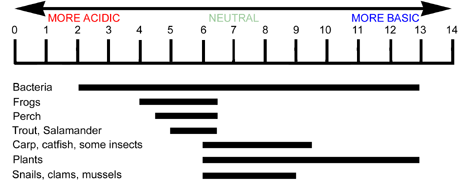The term pH is taken from the German word ‘potenz’ meaning power and H, the chemical symbol for Hydrogen. So when you are measuring the pH level, you are finding out the amount (or power) of Hydrogen ions present.
This measurement is important because it can tell you whether water is acidic, basic, or neutral. Below is a scale that shows you some pH values of substances you are probably familiar with.

Aquatic organisms live best in waters that have a certain pH value. Scientists study the pH values of water because a changing pH could indicate increased pollution or some other environmental factor.
Polluted rain can be very acidic and affect the environment in a negative way. When coal or gasoline is burned as a source of fuel, the sulfur dioxide (SO2) and nitrogen oxides (Nox) released in the smoke mix with water vapor in the air to form sulfuric or nitric acid. The water then falls to the ground as acid rain. If the rain is too acidic it will kill plants, fish and other organisms in the environment. Below is a scale that shows the pH ranges that support aquatic life.

Questions:
These airborne pollutants mostly come from car exhaust, industrial factories and coal burning power plants.
Water becomes more acidic as the pH value decreases.
